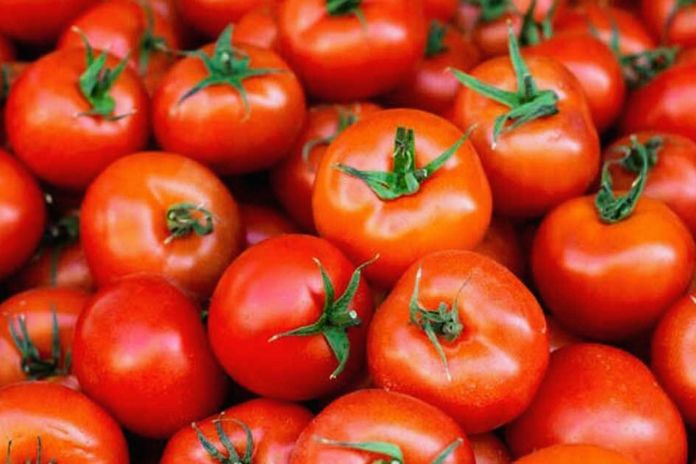Protects the heart. Help the intestines to function. It is valuable against obesity and hypertension. Don’t overdo it if you have ulcer problems.
From May to late September, fresh tomatoes arrive on the Italian table. But even for the rest of the year, you can always have the canned one, the famous peeled tomato.
Tomato
The main characteristic of the tomato, from the point of view of the benefits it brings to our body, is that it is an excellent source of antioxidants. In particular, lycopene, which gives the tomato the red color: this molecule allows the tomato to have a preventive function concerning skin cancers. At the same time, zeaxanthin protects the eyes and vision and prevents age-related macular degeneration.
Tomato Nutritional Values
The tomato has low-calorie content, especially if it is ripe. Every hundred grams of ripe vegetables contain only 19 calories. And then:
- 3.9 grams of carbohydrates
- 1.2 grams of fiber
- 0.9 grams of protein
- 0.2 grams of lipids
- 237 milligrams of potassium
- 24 milligrams of phosphorus
- 11 milligrams of magnesium
- 10 milligrams of calcium
- 5 milligrams of sodium
Properties Of Tomato
After the potato, tomatoes are the most cultivated vegetables in the world. Considered the symbol of the Mediterranean diet, the tomato arrived in Italy from the Americas in 1500. Originally from South America, the tomato plant belongs to the Solanaceae family, including aubergines, peppers and potatoes.
Thanks to high water content, the tomato contributes to good hydration, is a diuretic, counteracts water retention and reduces the overall caloric intake. It contains a lot of potassium to keep blood pressure within limits and is essential for muscle function and cellular exchanges. It also has few sugars and a good dose of vitamin C with an antioxidant effect, favoring the immune system’s proper functioning. Other fundamental components of the tomato are phosphorus, magnesium, calcium and sodium. And it is also helpful in detoxifying the liver.
Benefits Of Tomato
Thanks to its fiber, it adequately nourishes the “good” intestinal bacterial flora, promoting the correct balance of our intestine. It is essential to stay healthy and keep various diseases at bay, including tumors, allergies, hypertension, prostatic hyperplasia, autoimmune pathologies, and obesity. The tomato is also well equipped with bioactive molecules such as antioxidant polyphenols, precious against aging. It is also known for its antioxidant and anti-inflammatory content, lycopene which colors it red and serves for the proper functioning of the immune system and the prevention of tumors. Lycopene is a valid cellular scavenger, capable of counteracting the activity of free radicals with excellent results: hence the benefits, in preventive terms, for our body.
The tomato is low-calorie and therefore perfect for slimming diets, as well as protects our cardiovascular system from “bad” cholesterol, inhibiting the formation of atherosclerotic plaques at the origin of cardiovascular diseases. Low in sugar, the tomato can be consumed without problems even by diabetics, and, according to some studies, it would be able to normalize blood glucose levels.
Benefits Of Raw Tomato
Vitamin C is better absorbed by eating raw tomatoes, while lycopene is cooked if it is cooked: in fact, the temperature breaks the cell walls making it more usable. A precious tip: pour a drizzle of extra virgin olive oil added raw on the cooked tomato to keep the properties of the sauce intact. Tomato sauce is a healthy food that can bring even children closer to proper nutrition. Each vegetable type is rich in mineral salts, vitamins and beneficial bioactive molecules.
How Many Tomatoes Can We Eat A Day?
Due to its organoleptic characteristics, the tomato can be eaten in abundance. But without exaggerating. Otherwise, you risk heartburn (the tomato is still acidic) and kidney problems (due to the high percentage of potassium, oxalates and water). The right dose, in order not to have any problems, is the equivalent of a third of a cup of tomatoes a day.
Contraindications Of Tomato
Avoid eating tomatoes in case of a specific allergy and intolerance to the Solanaceae family or an allergy to nickel, an element in this vegetable. Furthermore, if you suffer from stomach acid, gastritis or reflux, you must be careful with the consumption of tomatoes because it can worsen the symptoms. Also, do not abuse tomatoes if you have ulcer problems, gastroesophageal reflux and heartburn. You may find yourself with severe headaches.
How To Use Tomatoes In The Kitchen
The use of tomatoes in the kitchen has no limits. And it ranges from pasta to any first course, from fish to meat. These are some of our site’s best and most original tomato recipes.
- GREEK SALAD. The tomato combines feta, olives, cucumber and onion (preferably from Tropea ).
- TOMATO SAUCE. A classic of health and the pleasures of the table.
- GAZPACHO. Refreshing, pleasant and healthy aperitif.
- GREEN TOMATO JAM. Perfect for seasoning cheeses.
- STUFFED TOMATOES. A simple dish, filling and very quick to prepare.

